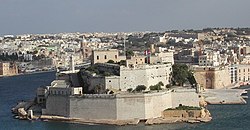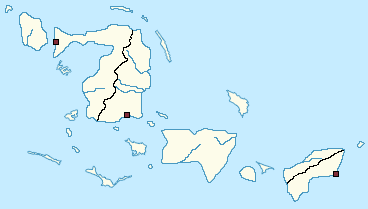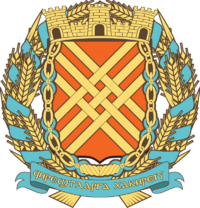Girbeta
This article is incomplete because it is pending further input from participants, or it is a work-in-progress by one author. Please comment on this article's talk page to share your input, comments and questions. Note: To contribute to this article, you may need to seek help from the author(s) of this page. |
Tichvaist Union of Girbeta ⲃⲉⲣⲗⲉⲭⲧⲏⲭϥⲁⲓⲥ ϣⲓⲣⲃⲉⲧⲁⲥ Berlekthichfaiyk Jiyrbetäk (Girbetese) Union Tichvaiste Jourbetique (Mirician) | |
|---|---|
| Motto: "ϥⲏⲣⲉϣⲧⲗⲁⲣⲅⲁ ϭⲁⲕⲣⲉⲓⲩ" "An Appeal to the Angels" | |
| Capital and largest city | Saybäketle |
| Official languages | Girbetese, Mirician |
| Recognised regional languages | Regional languages in Girbeta |
| Ethnic groups (2011) | 61.4% Babarik 26.6% Loaloa 8.2% Other Jabattan Islander 3.9% Majulan 0.1% Other |
| Religion | Tichvaism |
| Demonym(s) | Girbetese |
| Government | Federal multi-party ecclesiocratic-republican semi-presidential republic |
| Moushira Sabbagh | |
| Teremun Shalhoub | |
| Legislature | National Consultative Assembly |
| Chamber of Elders | |
| Chamber of Deputies | |
| Formation | |
• Settlement by the Girbetese | c. 1430 CE |
• Tichva Confederacy | 1450-1602 |
• Colony of Miricia | 1602-1866 |
• Kingdom | 18 August 1866 |
• Tichvaist Union | 5 October 1957 |
| Area | |
• Total | 180,386,941 km2 (69,647,787 sq mi) |
• Water (%) | 2.4 |
| Population | |
• 2019 estimate | 65,005,659 |
• 2011 census | 62,505,442 |
• Density | 2.88/km2 (7.5/sq mi) |
| GDP (PPP) | 2019 estimate |
• Total | 1,063,905,128,282 US$ |
• Per capita | 17,021 US$ |
| GDP (nominal) | 2019 estimate |
• Total | 430,162,451,844 US$ |
• Per capita | 6,882 US$ |
| Gini (2016) | low |
| HDI (2017) | very high |
| Currency | Girbetese Bakir (GIB) |
| Date format | dd/mm/yyyy |
| Driving side | right |
| ISO 3166 code | GI |
| Internet TLD | .gi |
Girbeta (Girbetese: ϣⲓⲣⲃⲉⲧⲁ, romanized Jiyrbetä), officially the Tichvaist Union of Girbeta (Girbetese: ⲃⲉⲣⲗⲉⲭⲧⲏⲭϥⲁⲓⲥ ϣⲓⲣⲃⲉⲧⲁⲥ, romanized Berlekthichfaiyk Jiyrbetäk), is a transcontinental country with inhabited territories in both Rennekka and Frigidarum.
Though its culture is heavily defined by its Tichvaist Babaro-Girbetese (Babarik) heritage, Girbeta's history is also richly influenced by the Loaloa peoples, who migrated into the region sometime around the 11th Century CE. As knowledge of the Jabbattan Islands extended into the Eastern Hemisphere, the Tichvaist community among the Babariks, facing a renewed wave of religious persecution, began migrating further south down the Western Coasts of Majula before making expeditions into the region in the 13th Century, formally settling the island of Jar and establishing what would become the modern capital city of Saybäketle, which would gradually become the primary locus of cultural importance to the increasingly-multicultural Girbetese, with the Loaloa and Babarik cultures slowly blending through a mutual importance placed on the highly syncretic Tichvaism, facilitating the expansion of the Great Southern Confederacy across most of the modern landmass controlled by Girbeta by 1600. With the onset of the Age of Exploration carrying out across the globe by the end of the 15h Century, Girbeta was uniquely positioned as a prime commercial center between the hemispheres, leading to a rise in foreign influence over the often-fractious city-states which comprised the Confederacy. This would gradually lead to the dismemberment of the Confederacy, ending with the conquest of Jar after a prolonged siege of Saybäketle, which helped to spark the development of the Girbetese national identity. Under the colonial domination of Miricia, attempts were made to dismantle Tichva among the islands, which only served to increase resistance to the foreign presence in the territory. After a failed but violent revolt in 1801, a number of reforms were made, leading to the establishment of a semi-independent kingdom in 1866. Full independence would be achieved in 1951, though would be quickly followed by increasing civil disobedience in response to rampant corruption of the colonial government, many of which's institutions were still firmly in place post-independence. This led to a series of mass strikes in 1955, alongside increasingly violent police actions. This spurred many governmental agencies to act against the Crown, culminating in the military siding with the Dissenters at the end of that year, forcing the King to abdicate. this would lead to significant political violence through the rest of the decade, though would end in the peaceful adoption of a new constitution, which formed the basis of the modern Tichvaist Union.
Girbeta's political system is a unique blend of a multiparty semi-presidential democracy and ecclesiocracy, with a popularly-elected head of state, and two co-heads of government - with the head of the lower house elected from outside the clergy, and the upper house appointed from within. Despite this, after significant reforms in the latter quarter of the 20th Century, Girbeta is described as an open society, which shares many of the same features of other modern secular, liberal nations. However, in the present, the country still struggles to overcome a long history of sectarian violence, inter-ethnic tensions, and economic underdevelopment rooted in its history under colonial rule. Despite these shortcomings, Girbeta has a high degree of income equality and a high Human Development Index score, as well as being a world leader in green energy development.
Etymology

The Girbetese name ϣⲓⲣⲃⲉⲧⲁ (Jiyrbetä) has been in recorded use since the settlement of Saybäketle. The commonly-used folk etymology of the name is "The Place where the land runs out", citing a common saying among the Girbetese on the condition of their culture over the course of history: "Our people are at home at the edges of the world. We are the tree on the cliff, the only thing that survives where the land runs out." The precise origin and chronological placement of this statement is unknown, but is purportedly used around c. 1400 CE, with Girbetese historians generally believing it to be first utilized prior to the Exodus from Majula.
During the earlier phases of settlement by the Girbetese, the term ϩϣⲁⲣⲓⲣ (Jahriyr), translating to "shoreline", "fringe", or "distant place" was also utilized in reference to the eastern settlements of the modern country in particular. This was in reference, likewise to its current name, to the land's place as being on the most distant known lands at the time. Today, this nomenclature endures through the modern Jar Governorate.
As per the 1952 Constitution, the official name of the nation is Berlekthichfaiyk Jiyrbetäk(the Tichvaist Union of Girbeta).
Geography
Mannatiua is an island chain in the Southern [ATLANTIC] Ocean, and is part of the Greater Babaran Archipelago. Forty of these islands are permanently inhabited, though altogether a total of around 700 islands and cays are present in the nation's territorial waters. Roughly 80% of the population resides on the "five crowned heads", the five largest islands in the nation - Jar, Kamatiyk, Lefu Buka, Loaloadan, and Kiyryagiynčy, from east to west, respectively. The largest island, Loaloadan, is also the largest in the Archipelago. The capital city of the nation, Saybäketle, is located on Jar.
Climate
History
Pre-Exodus Girbeta
The Babaran Exodus
Early Girbeta
- First settlements in modern territory around 1430
Confederacy
- Defense of Saybäketle in 1601 becomes a legendary moment in the nation's history, begins the cementing of the Girbetese national identity
Colonial Era
Kingdom of Girbeta
- Kingdom becomes a Dominion of Miricia in 1866
- Dap Agreement formalizes the full independence of Girbeta in 1951
- Royalty implicated in serious financial crimes and bribery related to sales of oil exports and an ensuing coverup (including a purge of internal bureaucrats investigating it) which had been going on since 1948, becomes known as the White Shallows scandal
- Military sides with protesters in 1955, military brass demands abdication of the monarch. The king refuses, and orders the Royal Girbetese Police to arrest the officers after they refuse to stand down, beginning the Officers' Coup.
- Very little foreign support for the monarchy, perceptions of low legitimacy following the revelations of widespread pervasiveness of corruption in the royal government, as well as excessive use of police forces to track and suppress dissenters.
- Coup lasted from 19 April to 27 July, when Miricia agreed to hold the deposed monarch in house arrest.
- Last monarch died in Nakeba in 1970, having been allowed to return to the country in his final days.
Transitional Period
- First elections in 1956
- Last major outbreak of pro-monarchy violence brought to an end in 1959
Tichvaist Union
- Concerns on the rise over the power of the clergy start almost immediately after the ratification of the Constitution, with secularists calling for major land and officeholding eligibility reforms and the establishment of a more co-equal relationship between the clergy and general public in national politics through a more empowered secular executive
Contemporary Girbeta (1977-Present)
- Executive Secretariat established as a separate governmental branch from the legislature in the 1976 Reforms, put into effect in 1977
- Moussera Sabbé becomes first transgendered individual to gain a role as head of state in the world in 2019.
Government and Politics
- Main Article: Politics of Girbeta
Executive Secretariat
- Main Articles: Executive Secretariat of Girbeta, Executive Secretary of Girbeta
National Consultative Assembly
- Main Articles: National Consultative Assembly of the Tichvaist Union of Girbeta, Chamber of Elders (Girbeta), Chamber of Deputies (Girbeta, Chief Deputy of Girbeta
- Further Information: Party politics in Girbeta
Administrative Divisions
- Main Articles: Governorates of Girbeta, National cities of Girbeta, Regions of Girbeta
Following the establishment of the 1976 Amendments to the Girbetese Constitution and the accompanying redefinition of the nation's subnational borders, Girbeta has been comprised of nine Governorates, three National Cities, and one territorial administration. It is organized as a federation. Governorates and National Cities are generally autonomous in the conduct of their politics and internal governance, though they rely on the federal government in order to gain resources for allocation to programs and services.
These subnational units are not comparable in terms of population, and allocations by the federal government are thus based on population figures, which are adjusted every census year, with the next reappraisal to take place in 2021. To help account for this disparity, each local government is part of a greater regional government, centered on the five main islands of the Girbetan Archipelago. This is intended to give each area a greater ability to coordinate resources within their cultural identity blocs, especially in regards to the planning and execution of regional development goals. Each region is overseen by a Regional Executive Commission, modeled on their federal-level counterpart, which is composed of three representatives appointed from each Governorate's legislatures, with eligibility defined by proportional representation. National Cities and Territorial Administrations are not included in overlying regional governments, as they are overseen directly by the federal government.
Governance of each Administrative Division is divided between the national, regional, and local governments, all of which have specific and implied powers through the national constitution. Each Governorate is overseen by a unicameral Local Governing Assembly, which is composed of representatives from single-member constituencies (known as Parishes), and elected via Mixed member proportional system. Each Parish is further subdivided into municipal administrations, known as communes and townships. Each Assembly is is mandated to have at least two representatives from each Parish - one from the general public, and another representing the Tichvaist Clergy present there. The Girbetan model of federalism is unique in that additionally, Governorates each have their own legislatures, while sharing a singular executive across their wider region, the previously-discussed Regional Executive Commissions.
|
Law and Order
Military
- Main Article: Girbetese Armed Forces
- Further Information: List of wars involving Girbeta
The Girbetese Armed Forces (GAF) is the sole military apparatus of the Federation, and is headed by the General Staff, which is composed of elected officials from within the chief officers of each service branch, which acts in many ways similar to the Executive Commission, which the General Staff is ultimately subject to the authority of. The branches present under the banner of the GAF is the Girbetese Republican Army, Girbetese Navy, Girbetese Air Force, and the Girbetese Strategic Support Services. Additionally, the GAF draws upon the resources and assistance of Mirage, Girbeta's national intelligence service, as well as the National Police Service when necessary. The current charter of the GAF states that its organization is solely for defense of Girbetan territorial integrity, the security of domestic economic, social, and political interests, and international peacekeeping or disaster relief missions. The GAF is not permitted to join ongoing military conflicts unless a direct threat to Girbetese interests is observed, and even then requires the express approval of both houses of the National Consultative Assembly.
Under its current form, the GAF is a fully volunteer military. While general peacetime conscription is illegal under the constitution, the Directorate can call for its reinstatement in times of national emergencies. In an attempt to capitalize on knowledge of difficult terrain and the rise of expansionist rhetoric among nearby states, all citizens receive emergency preparedness and basic marksmanship skills training. Citizens over the age of 18 are required to keep and maintain two working government-issue firearms: the AP-89 and AV-02 (a 9×19mm Parabellum semi-automatic pistol and submachine gun respectively), as well as undergo regular retraining seminars every five years. Beyond this, many citizens of Girbeta own additional firearms, mainly long rifles and shotguns, usually for the purposes of pest control or hunting. This is especially true in less-developed areas, where hazards caused by local wildlife are more prevalent in day-to-day life.
Foreign Relations
- Main Article: Foreign Relations of Girbeta

Since the establishment of the constitutional government and the first elections under the new government in 1961, the Tichvaist Union has engaged in diplomatic relations with the vast majority of all extant sovereign states. Girbeta is generally considered a middle power in world affairs, and is the seen as one of the major powers of the South Seas region, and the !Atlantic rim at large. While its closest relationships are with other nations in in the South Seas and Frigidarum, Girbeta maintains a "special relationship" with Miricia, with the nation developing a largely positive relationship with its former colonizer in the years since its 1866 dominion status and later independence. It is a member of the OIM, and benefits from numerous cultural and political connections brought on thanks to it.
The legacy of the modern Girbetese nation in world affairs since the 1960s has been one of a voice against unabated globalization, and for the protection of indigenous cultures and traditional societies from market forces. This is generally known as the "Bezneñ-šartlar" ("Our own way") policy, in which the developing and recently-industrialized countries of the world are to be encouraged to cooperate with more affluent nations, while said affluent nations must be prevented from permitting neocolonial acts of exploitation or predatory commercial practices that might harm local sovereignty, thus encouraging a global culture of egalitarian economics and political relationships.







